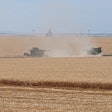We gathered leaders from around the industry to ask their thoughts on last week’s presidential election and where they see 2021 headed for the feed and grain industry.
Our panelists included: Leah Wilkinson, vice president of public policy and education, AFIA (American Feed Industry Association); Randy Gordon, president and CEO with NGFA (National Grain and Feed Association); and Liz Friedlander, director of policy communications with NCGA (National Corn Growers Association).
Q: Vice President Joe Biden has won the 2020 presidential election – what does that mean for the feed & grain industry?
A: Leah Wilkinson, vice president of public policy and education,AFIA:President-Elect Joe Biden has indicated that his first priority in office will be to put into place a national strategy for curbing the spread of COVID-19, which we expect may change the way our businesses have been operating at the state and local levels, with the goal of promoting access to medical care, testing and providing financial support to businesses that are hurting.
Biden has also indicated a desire to “fix” broken relationships with the United States’ trading partners by pursuing multilateral trade deals, as opposed to Trump’s focus on bilateral trade agreements, and a push toward supporting new jobs and investing in rural infrastructure, from bridges to broadband. The coronavirus pandemic has exposed the need for broadband in many areas where our animal food manufacturing facilities are located, which will allow them to stay competitive in the new environment and reshape the way they conduct business and inspections in a virtual environment. Biden is also strongly in favor of launching a climate change strategy and the industry is hopeful to be a solution provider in this initiative.
A: Randy Gordon, president and CEO,NGFA:From a policy standpoint, NGFA would anticipate a return to a more multilateral negotiating approach to trade and WTO reform. NGFA also would anticipate more of a regulatory approach to workplace safety and environmental issues. On agricultural policy, NGFA would anticipate a Biden administration would place more emphasis on consumer/small farm/organic and climate change policy initiatives.
We also would anticipate a significant proposed legislative initiative focused on infrastructure, including transportation and rural broadband, as well as COVID-19 relief legislation with more emphasis on unemployment insurance and relief for state and local governments than might be proposed under a second Trump administration. The new administration likely also will revisit the corporate tax rate and the Republican-led Tax Cuts and Jobs Act of 2017, as well as initiate additional health insurance legislation.
安妮·汤普森,可怕ctor of PAC and Political Strategy withNCGA:President-Elect Biden has highlighted policies to address climate change as a top focus. We believe agriculture can be a key player in these discussions. Corn farmers, through continuous innovation in crop production, provide carbon reduction benefits. Policies that support carbon reduction can also support use of ethanol, a low-carbon fuel.
Q: What challenges does our industry face in 2021?
A: Wilkinson, AFIA:Getting the coronavirus pandemic under control is the number one issue impacting the U.S. animal food manufacturing sector, as it is for many U.S. industries right now. We depend on our nearly 1 million employees across the sector each day and ensuring they are safe and healthy and can report to work is a priority in our ability to continue providing an essential service to America – keeping the food supply chain stocked with protein and dairy products and pet food.
Beyond that, we need to ensure the overall health of the livestock sector can stay competitive throughout the crisis and emerging from it, meaning trade deals that support U.S. agricultural products in the future are critical to expanding the marketplace. There are many opportunities in the works, including a trade deal with the United Kingdom, European Union, Vietnam and in parts of Africa, and we have been working with the U.S Trade Representative and others to ensure our members’ needs are heard.
Our industry continues to be plagued by overly burdensome regulatory processes that hinder innovation from making it to the marketplace in a timely fashion, so continuing to focus on areas where we can improve is necessary to ensure we are not left behind in the global landscape.
除了这些问题之外,AFIA,许多合作伙伴throughout the livestock sector, will remain focused on mitigating the introduction of foreign animal diseases in the United States, which have the potential to even further decimate the wellbeing of farmers and ranchers who are struggling in this tough economic environment.
A: Gordon, NGFA:The grain and feed industry and America’s farmers and ranchers are in the midst of a very promising and strong surge in export and domestic demand for grains, oilseeds, and their derived products, as well as feed and feed ingredients and meat and poultry products that will require reliable, predictable, efficient and competitively priced transportation service.
NGFA members have expressed nervous apprehension about whether the major freight railroads, in particular, will be able to meet the strong demand for rail service that we anticipate will continue well into 2021, given the rebound in the domestic economy which has led to increased intermodal and other traffic. The nation’s railroads understandably furloughed crew members and idled locomotive capacity during the worst of the pandemic given the downturn in consumer demand and the need to protect employee safety. But the grain and feed industry needs the rail sector to respond quickly to restore these assets to serve customers, particularly given tight truck capacity.
在饲料行业,尽管重要的矩形overy has occurred within the animal protein sector since the start of the COVID-19 pandemic, potential challenges still remain. Major COVID outbreaks in the future could again disrupt livestock and poultry plant processing capacity that has been able to largely normalize since March. Experiences during the pandemic have illustrated how supply chains are intricately interwoven and finely tuned to meet demand. If COVID does once more disrupt livestock and poultry processing capacity, the impact will ripple up and down the supply chain and affect the grain and feed industry.
The African Swine Fever (ASF) virus also presents a significant potential risk to U.S. animal agriculture and its allied industries. Although ASF does not affect human health, countries with confirmed cases are subject to international trade restrictions to reduce the potential spread of the highly infectious disease within the hog sector. U.S. pork production exceeds domestic consumption by 25 to 30 percent, so export markets are essential to the vitality of U.S. swine producers and their suppliers. The threat of ASF warrants continued vigilance by the U.S. Department of Agriculture, Food and Drug Administration, swine producers and the feed industry.
In addition, demand for ethanol continues to face headwinds from COVID-induced reductions in transportation fuel demand. A rapid recovery from COVID would spur ethanol use whereas a return to lockdowns would be harmful to ethanol demand.
A: Thompson, NCGA:2020 was a tough year for agriculture and if the economic outlook for 2021 holds true, we'll have a tough year ahead of us. Corn farmers are working to develop solutions today that can help the industry recover from the impact of COVID-19 and set the table for longer term opportunities to grow demand across all segments of corn use, from exports and animal agriculture to ethanol and the potential to increase demand from more new uses in industrial and other bioproduct sectors.
Q: Briefly, what legislative priorities are top of mind for your organization in 2021?
A: Wilkinson, AFIA:The American Feed Industry Association will continue to advocate for economic relief for businesses and Americans that have been hurt by the coronavirus pandemic. We have heard from our members how programs, such as the Paycheck Protection Program, have been vital to keeping people employed and businesses running, and will continue to support similar economic relief packages. We will also continue to support federal funding to expedite ingredient review approvals at the Food and Drug Administration for agricultural research and programs that will be essential in curbing the spread of animal diseases within our country. The industry will also be seeking legislation to improve rural access to broadband and reauthorization of Trade Promotion Authority, which expires July 1.
A: Gordon, NGFA:NGFA’s core purpose is to advocate for competitive open market principles to promote the growth and economic performance of North American agriculture in a global marketplace. In 2021, our Association will continue to do this by focusing on infrastructure and trade policy. Specifically, NGFA will be urging Congress to invest in a long-term highway bill reauthorization with policies that increase trucking capacity; pursue policies to reform rail rates and clarify the common carrier obligation of railroads; and reduce the backlog of inland waterways navigations projects to modernize our aging locks and dams, especially those on the Upper Mississippi River and Illinois Waterway.
Finally, because the 117th Congress won’t be sworn in until January 3, 2021, NGFA will continue to urge the anticipated lame-duck post-election session of Congress to renew the U.S. Grain Standards Act, under which official grain inspection and weighing activities are conducted, and approve a new Water Resources Development Act (WRDA) to continue momentum to improve America’s inland waterways and ports. If the lame-duck session of Congress is unable to reauthorize these two significant pieces of legislation, the legislative process unfortunately would need to start from scratch when the new Congress is sworn into office in January.
A: Thompson, NCGA:NCGA's top priority is always to build demand for our product. To that end, the organization's top legislative priority for the new year is the Next Generation Fuels Act, legislation that would grow future demand for corn. Continuing to stand up for trade and export markets will also be important in a new administration.
Q: When it comes to our industry, what are you hopeful for in 2021?
A: Wilkinson, AFIA:Our member companies have done a phenomenal job this year adapting to the ‘new normal,’ despite all the personal and professional pressures placed upon their workforce from the coronavirus pandemic. We know it has not been easy and have been working with our members to share lessons learned and identify ongoing challenges so we can be better prepared to meet 2021’s challenges head-on and create our ‘next normal’.
We are in a much better place now than we were eight months ago and are hopeful the New Year will bring a renewed sense of optimism for scientific progress, particularly on the vaccine front. We salute the medical and scientific communities on the frontlines battling this pandemic at lightning speed and just as they continue showing up for work, we will continue doing our part to keep grocery store shelves stocked and our pets’ food bowls full.
A: Gordon, NGFA:First and foremost, as with all global businesses and indeed humanity as a whole, the grain and feed industry is hopeful for a return to some semblance of normalcy from the pandemic. Our industry and its workforce adapted quickly and performed an outstanding service as an essential industry in largely remaining in operation throughout the pandemic to serve U.S. and global consumers.
NGFA also is hopeful that its extremely active safety efforts – particularly directed at preventing grain bin engulfment incidents – will contribute to a decline in the number of these incidents, most of which occur on-the-farm. NGFA and its Foundation have a proactive approach for communicating safety information both to our industry and to farmer-customers.
NGFA also has several feed industry priorities in the coming year:
- FSMA Implementation:NGFA将积极倡导行业职位the U.S. Food and Drug Administration (FDA) pertaining to its on-going implementation of the Food Safety Modernization Act (FSMA). This includes communicating with FDA on issues related to its inspectional activity, and responding to rulemakings associated with additional traceability requirements, amending the food facility registration regulations, and revising the preventive controls rule for animal food.
- ASF Virus:NGFA will engage with other industry stakeholders and regulatory agencies to address the potential introduction of foreign animal diseases, including the ASF virus, into the United States through grain and feed products. The Association will advocate for a science-based approach to evaluate risk and prudent research to address information gaps concerning the possible role feed and grain products may play in transmitting viruses.
- Feed Ingredient Approval/Recognition Processes:NGFA will advocate greater efficiencies within the feed ingredient approval/recognition processes administered by the Association of American Feed Control Officials (AAFCO) and FDA so that new feed ingredients can be brought to the marketplace in a timelier and less costly manner. In addition, NGFA will work with other stakeholders on a potential framework that could provide regulatory officials greater assurances about the safety of independently concluded generally recognized as safe (GRAS) ingredients.
A: Thompson, NCGA:Farmers are, by nature, optimists. We're looking forward to putting 2020 in the rearview mirror and continuing our work to feed and fuel the nation. As the potential for climate policy begins to come into focus, we see opportunity for agriculture to be part of the solution. We look forward to building upon existing relationships and forging new ones to assure corn ethanol is at the table. With USMCA being implemented and increased exports of corn to China, we are optimistic for the prospect of shifting to offense on trade policy to actively pursue new agreements and markets that open demand for corn and corn products.





















